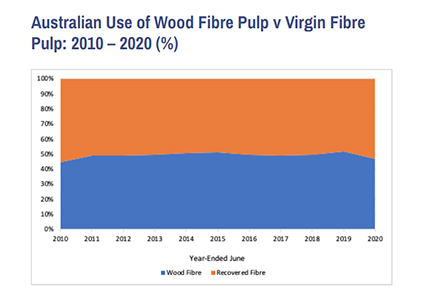Australia’s apparent consumption of virgin fibre pulp fell 12.4% in 2019-20, according to IndustryEdge’s latest analysis. Driven lower by the closure of Norske Skog’s Albury mill in late 2019, total virgin pulp consumption fell to 1.581 million tonnes, the lowest level in a decade. Source: IndustryEdge
Although most of the impact was on mechanical pulp (-45.2% on 2018-19), chemical pulp consumption was also 2.1% lower.
The fibre consumption model shows that implied recovered paper use lifted 14.0% to 1.780 million tonnes. While that is feasible, expectations after discussion with some manufacturers is that is likely to be too high, with pulp inventories having taken up some of the volume over the year. This is strategically important information for the national industry, and potentially for policy makers.
While it is expected that 2019-20 was an ‘outlier’ year in many respects, it is also likely to be signalling a significant pattern change. After more than a decade of equilibrium, if not dominance, utilization of virgin fibre pulp is waning in Australia.
There are distinguishing features to the most recent year. The following may mean a return to the fibre equilibrium of the past decade is just a year away, but in general, that is unlikely.
What set 2019-20 apart includes:
- Closure of the Albury mill (permanent reduction in wood fibre and recovered fibre use)
- Lingering drought reducing primary production and impacting demand for packaging materials
- Extensive bushfires impacting primary production and reducing demand and supply of virgin fibre
- Recovered paper export challenges meaning more supply of recovered paper was available at lower prices than any time in the two previous decades
- Increased deliveries to households (B2C) increasing throughput of lower value corrugated boxes, containing on average a higher proportion of recovered fibre (based on interviews with producers)
- Moderately decreased exports of food and other products typically shipped in virgin fibre corrugated boxes
Hence the implied proportion of recovered fibre used in Australia has returned to more or less the position it held a decade ago.






